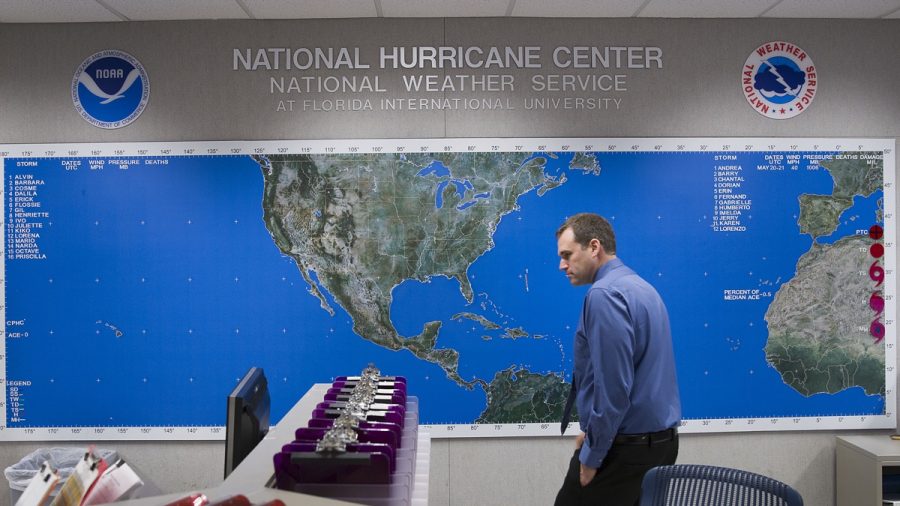The Bay of Campeche in the Gulf of Mexico is under storm watch on June 1—the first day of the 2019 Atlantic hurricane season.
“Today is the first day of the 2019 hurricane season and there is a system that NHC is monitoring for development,” said the National Hurricane Center (NHC) on Twitter. “A broad low over the Bay of Campeche has a medium chance of becoming a tropical cyclone before it reaches the coast of Mexico in a few days.”
Today is the first day of the 2019 hurricane season and there is a system that NHC is monitoring for development. A broad low over the Bay of Campeche has a medium chance of becoming a tropical cyclone before it reaches the coast of Mexico in a few days. https://t.co/tW4KeFW0gB pic.twitter.com/qzDyxL18Eb
— National Hurricane Center (@NHC_Atlantic) June 1, 2019
According to the NHC website, the weather system disturbance that is entering the Gulf of Mexico this weekend has a 60 percent chance of cyclone formation in the next 48 hours.
The website said that recent satellite data indicates that the circulation of a low pressure system has become more defined over the southern Bay of Campeche.
According to the NHC, the weather system is expected to move slowly west-northwest toward the coast of Mexico, with the potential to become a tropical cyclone before moving inland.
The NHC said the next few days will most likely produce heavy rainfall over portions of southern and eastern Mexico, regardless of whether a cyclone develops or not.
If necessary, the Air Force Reserve will send a reconnaissance aircraft to investigate the disturbance on June 2.
NHC is monitoring a disturbance with a low chance of development that is expected to move over the southern Gulf of Mexico this weekend. Regardless of development, heavy rainfall is possible over portions of southern Mexico during the next few days. https://t.co/tW4KeFW0gB pic.twitter.com/BH1IEQUIYB
— National Hurricane Center (@NHC_Atlantic) May 31, 2019
Hurricane Awareness Tour
The National Oceanic and Atmospheric Administration (NOAA) and the U.S. Air Force (USAF) conducted an eleven city, 2-week-long tour this year to raise awareness and urge people to plan ahead for the hurricane season.

The eleven cities that are prone to hurricanes—six in the Caribbean and five along the Atlantic coastline—were visited this Spring by aviators and scientists that fly around and into the eye of hurricanes as they talked about hurricanes, meteorology, and safety.
The public and media were able to board and tour the airplanes used for hurricane missions: the USAF Reserve WC-130J named the “hurricane hunter”of the 403rd Wing, 53rd Reserve, and the NOAA 42 named “Kermit.”

Being Prepared
According to the Ready government website—a site designed to plan ahead for disasters—hurricanes can occur along any U.S. coast and affect areas more than 100 miles inland, as well as any territory in the Atlantic or Pacific oceans.
For information on how you can prepare for hurricane season see https://t.co/p0i31XawiI or https://t.co/YkD38WT2lj
— National Hurricane Center (@NHC_Atlantic) June 1, 2019
To prepare for a hurricane, the Ready website suggests the following precautions.
- Become familiar with evacuation zones, routes, and shelter locations.
- Find safe shelter right away when under hurricane warnings.
- Listen for emergency information and alerts.
- Evacuate if told to by authorities.
- Do not walk, swim, or drive through flood waters.
- Restock your emergency preparedness kit.
- Gather food and water sufficient for at least three days, medications, a flashlight, batteries, cash, and first aid supplies.
- Plan how to communicate with family members if you lose power. Texting is usually more reliable and faster than phone calls in case phone lines are overloaded.
- Keep your car in good working condition, and keep the gas tank full; stock vehicle with emergency supplies and clothes.
- Close storm shutters, and stay away from windows.
A full list of what to do before, during, and after a hurricane can be found on the Ready website.
With one named storm already this year in May over the western Atlantic called Andrea, the next storm will be called Barry.
Subtropical Storm #Andrea has formed over the western Atlantic. While some slight strengthening is possible tonight, the system is forecast to dissipate by Wednesday while it moves to the southwest or south of Bermuda. More info at https://t.co/tW4KeFW0gB pic.twitter.com/d6hKaD8nGD
— National Hurricane Center (@NHC_Atlantic) May 20, 2019
The Atlantic hurricane season runs from June 1 to Nov. 30, with the most active month being September. The Pacific hurricane season is from May 15 to Nov. 30.


